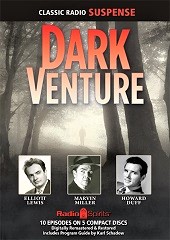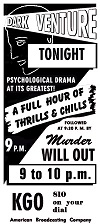Darkness is the absence of Light . . .
So in the sudden shadows which fog the minds of men and women
. . . into the unknown.”
Dark Venture (1945-47) aired “The Only Inhabitant” on November 18, 1946. This is but the second episode we have run of the show that was billed as a “psychological thriller.” As such, and to recap our original introduction for new listeners, I offer the original introduction below.
Aside from the fact that there were 130 episodes of which a mere dozen survive, there is so much mis-information, innacurate information, and conflicting information among many online old time radio websites (some reportedly reputable and authoritative), that I turned to long-time friend of this show and Golden Age of Radio historian Karl Schadow for help. Karl wrote the liner notes for the Radio Spirits CD collection of Dark Venture, and with his kind permission–and my thanks–I will excerpt from his far more in-depth introduction, wherein he details the history of this under-appreciated radio show.
“Dark Venture premiered on June 5, 1945, enjoying a continuous run through December of 1947. During this thirty-one month period, all of the episodes were produced and broadcast from various facilities of station KECA, ABC’s Hollywood affliate. The cast was an interesting mix of performers. Not only were elite actresses Jeanne Bates, Betty Moran and Lurene Tuttle featured in the series, but opportunities were also bestowed upon radio newcomers Daphne Drake and Martha Shaw. The men’s roles were often given to stalwarts Charles Lung, Earl Ross and Bill Johnstone. Stage and screen stars occasionally appeared on the program as well, resulting in impressive individual performances by William Tracy and Carl Harbord.
“For the frst ten months, Dark Venture was a regional feature, limited to broadcast on ABC’s Pacifc Coast network, which consisted of fifteen stations in fve states. After commencing on Wednesday’s at 9 pm, the program moved to Tuesdays in July of 1946. It is currently unknown why ABC did not initially route the program to the entire nation. However, on February 19, 1946, it did achieve full network coverage. Two months into this series, the New York Times (April 7,1946) published Larry Marcus’ compliment to the wisdom of his audience, who demanded scripts that would have to involve “believable characters and natural situations out of which will spring movement and suspense…to tell an honest story of emotional upheaval.”
…
“On April 16th, 1946, Dark Venture entered the commercial ranks. The Wildroot Company, through its long-time advertising agency Batten, Barton, Durstine & Osborn, signed on as sponsor to promote its Cream-Oil Hair Tonic through April 8, 1947.”
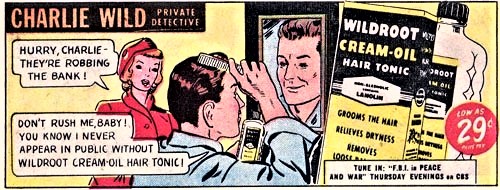
…
“Previously aired episodes of Dark Venture (from 1946) were adapted for use by the Armed Forces Radio Service (AFRS) and broadcast without Wildroot’s promotional copy. The program was one of many to be featured on the AFRS Mystery Playhouse. Hunter Galloway was this series’ narrator.”
And finally, “During the initial West Coast run of Dark Venture, the Hollywood-based Radio Life (January 27, 1946) acknowledged that the series “offers realistic psychological studies of men and women with troubled minds who choose the hard way, the fast way, the wrong way to solve their problems.” Once the program garnered a coast-to-coast audience, many newspaper editors expressed opinions similar to those of Mike Mann of Knickerbocker News, Albany, New York. He called the show “one of radio’s standout dramas…a psychological thriller with plenty of action.” Walter Winchell championed Dark Venture in his daily syndicated column (April 14, 1946), declaring it to be “gifted with fne word weaving–a rarity among radio dramas.”
***
“The Only Inhabitant” is a morality play, the story of one execrable human being who goes AWOL from the army, murders people for no good reason except for the pleasure it gives him, deals black market goods for outrageous prices when going back on his word on a previous price, and ends up in the wilds of China after a stinging twist in the story leaves him–this soulless, amoral sociopath–to ponder his fate as what is left of his miserable life crumbles around him. Not for the faint of heart.
Play Time: 29:23
{Ten days befoe Thanksgiving in 1946, when this Dark Venture episode aired, the nighborhood gang was looking forward to a brief vacation. To fill the void they met on the corner and headed for the nearby newsstand to see what had come in or what was still available. Astounding SF (1930 to present, now Analog) popped out at them with its colorful over and the promise of a Theodore Sturgeon story. “Mewhu’s Jet” was one of the stories in the 1955 Pyramid paperback collection A Way Home, a collection I heartily recommend. Astounding was a monthly in 1946. Doc Savage (1933-49) never disappointed with its sometimes world-hopping adventures, employing Doc’s intelligence and scientific expertise (with help from his erstwhile crew). The cover of this issue promised more creepiness for one of the neighborhood gang who wanted another adrenalin rush after listening to Dark Venture. Doc Savage was also a monthly in 1946. Planet Stories (1939-55) was a perennial favorite where imagination was paramount and ran wild. A good reason to pick up this issue might have been the cover story by Gardner F. Fox. Fox would go on to write many a DC Comic superhero story and pen a few of his own fantasy adventure novels as well. Off the top of my head I recall two that I heartily enjoyed back in the 1960s when I was in my mid-teens: Warrior of Llarn and Thief of Llarn. Planet Stories was a quarterly in 1946.]
[Left: Astounding, November 1946 – Center: Doc Savage, November 1946 – Right: Planet Stories, Winter 1946]
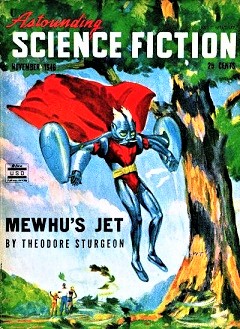
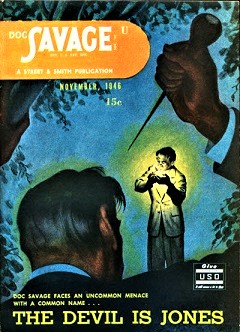
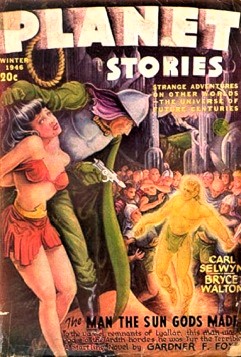
To view the entire list of weekly Old Time Radio episodes at Tangent Online, click here.
